
(Kenneth Garrett)
From left to right, the pyramids of the pharaohs Menkaure (r. ca. 2572–2551 B.C.), Khafre (r. ca. 2597–2573 B.C.), and Khufu (r. ca. 2633–2605 B.C.) rise above Egypt’s Giza Plateau. The two small pyramids (left) may have served as tombs for Menkaure’s queens.
On a summer afternoon around 4,600 years ago, near the end of the reign of the pharaoh Khufu, a boat crewed by some 40 workers headed downstream on the Nile toward the Giza Plateau. The vessel, whose prow was emblazoned with a uraeus, the stylized image of an upright cobra worn by pharaohs as a head ornament, was laden with large limestone blocks being transported from the Tura quarries on the eastern side of the Nile. Under the direction of their overseer, known as Inspector Merer, the team steered the boat west toward the plateau, passing through a gateway between a pair of raised mounds called the Ro-She Khufu, the Entrance to the Lake of Khufu. This lake was part of a network of artificial waterways and canals that had been dredged to allow boats to bring supplies right up to the plateau’s edge.

(Ken Feisel)
After offloading their cargo, the men anchored their boat in the lake alongside dozens—if not hundreds—of other boats and barges that had brought a variety of materials necessary to complete construction of the pyramid complex: granite beams from Aswan, gypsum and basalt from the Fayum, and timber from Lebanon. Also arriving by boat were workers from across Egypt and cattle from the Nile Delta to feed them. As the sun set and twilight deepened, hearth fires twinkled on land and on many of the boats. Merer and his men settled in for a night’s sleep, after which they would head back to the quarries to pick up another load of limestone blocks. They would make two or three such round trips in the next 10 days.

(Mark Lehner for Ancient Egypt Research Associates (AERA))
Marks made by a copper saw are visible in a piece of basalt paving found near Khufu’s pyramid on the Giza Plateau.
https://www.archaeology.org/
Με πολύ μεράκι αλλά και υπομονή συνεχίζουμε την προσπάθεια μας .Αθόρυβα …σιγά σιγά με πολύ υπομονή αλλά και διάθεση προχωράμε
Στόχος μας παραμένει να αρθρογραφούν οι πολίτες σε αθρα με θέματα πολιτισμού που επιλέξουν
Το όνομα και επώνυμο αλλά η ευπρέπεια των άρθρων είναι απαραίτητα .Η διεύθυνση μας για επιστολές Άρθρα είναι zantedanias@gmail.com
Όπως έχουμε από την αρχή της προσπάθεια μας αναφέρει θα αναρτώνται μετά από έγκριση μας
Σας ευχαριστούμε από καρδιας
Τα ενυπόγραφα άρθρα εκφράζουν το συντάκτη τους ο οποίος φέρει και την ευθύνη των γραφομένων και δε συμπίπτουν κατ’ ανάγκην με την άποψη της εφημερίδας
https://www.youtube.com/channel/UC0wk2ge3sheyTkgpAkeBang












Δημοσίευση σχολίου
Αφήστε το σχόλιό σας ή κάνετε την αρχή σε μία συζήτηση
Σημείωση: Μόνο ένα μέλος αυτού του ιστολογίου μπορεί να αναρτήσει σχόλιο.